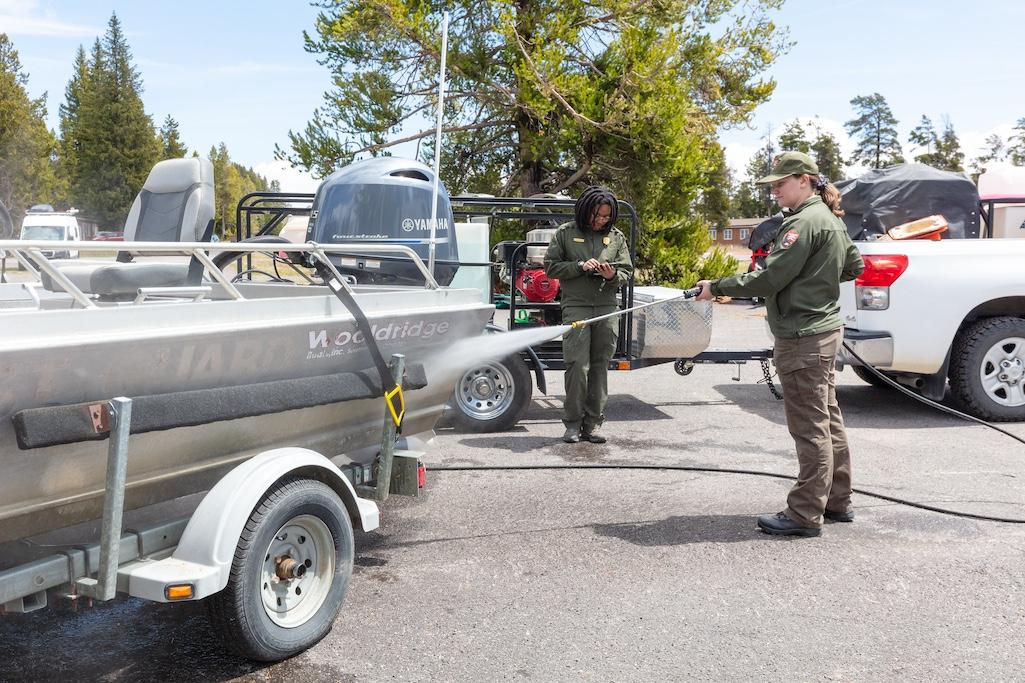
AIS technicians decontaminating a motorized boat and trailer/NPS, Jacob W. Frank
Yellowstone National Park is implementing additional measures to help stop the spread of aquatic invasive species into park waters. The restrictions include a 30-day mandatory dry time for sailboats and some types of motorized boats before entering park waters and the prohibition of watercraft previously fouled by mussels regardless of dry time.
These restrictions take effect Saturday, May 25, which is the first day of Yellowstone’s boating and fishing season. The season wraps up on October 31.
Yellowstone faces an increased risk of invasion by highly invasive zebra and quagga mussels following recent detections (2022 Pactola Reservoir in South Dakota; and 2023 Snake River in Twin Falls, Idaho) in waterways within a day’s drive of the park, a park release said. Mussels have caused irreversible ecological damage and extensive impacts to infrastructure and recreation in waterways throughout the Midwestern and Eastern United States, as well as in the lower Colorado River Basin. In both 2022 and 2023, Yellowstone’s AIS inspectors intercepted and denied launch to mussel-fouled watercraft, highlighting the urgency and severity of the threat.
30-Day Dry Time
To protect park waters and respond to this threat, there will be a 30-day dry time requirement for sailboats and certain complex motorized boats (inboard, inboard/outboard and inboard jet) prior to launching. Large, complex, trailered watercraft pose the highest risk of transporting and introducing invasive mussels and other AIS because they are difficult to inspect and less likely to completely drain/dry or be fully decontaminated. Manual decontamination with the use of hot water is not always 100 percent effective in removing all mussels. A 30-day dry time will mitigate the risk.
Previously Fouled Watercraft
Watercraft (motorized or non-motorized) previously fouled by mussels, regardless of dry time, will be denied launch. The launch of fouled watercraft increases the chances of false mussel detection by routine environmental DNA monitoring of park waters. This could result in significant impacts to operations and public recreational opportunities.
Prevention
These restrictions will build on existing protections, including the 2019 prohibition on watercraft equipped with sealed internal ballast tanks, as well as the 2022 prohibition of watercraft with evidence of live or dead mussels.
Yellowstone National Park straddles the Continental Divide and is located at the headwaters of the Yellowstone, Snake, and Missouri River drainages which flow into the Gulf of Mexico and Pacific Ocean drainages. These proactive measures are required to ensure the long-term ecological integrity of park waters and downstream mussel-free waters in Wyoming, Montana, and Idaho. Failure to prevent invasion by zebra and quagga mussels could result in widespread negative impacts to natural resources, recreational values and local businesses, and could undo over two decades of work to restore native Yellowstone cutthroat trout to the park. Prevention of an AIS introduction is critical because there are no effective eradication methods, and control/containment is both costly and environmentally consequential.
30-Day Public Comment Period
The park recently concluded a 30-day public comment period, and the majority of comments received were in favor of the restrictions and understand the increased threat and need to protect the park and downstream watersheds.
Clean, Drain, Dry
Boaters and anglers are reminded to clean, drain, and dry all boats, trailers and equipment prior to arriving in the park to minimize the risk of introducing AIS into Yellowstone’s waters. Felt-soled footwear is banned because they can carry microscopic disease organisms even after cleaning.
Clean all plants, animals, mud, sand and other debris from your boat, anchor, boots and equipment. Use high-pressure, hot (120-140 F) water if possible.
Drain all water from your boat, including the motor, bilge, livewell and other compartments before you arrive. Leave drain plugs out during transport. Do not move water or organisms from one water body into another.
Dry all compartments and equipment in the sun for five days.
Clean, drain, and dry requirements are critical steps to protect the park’s and nation’s waterways.



Add comment